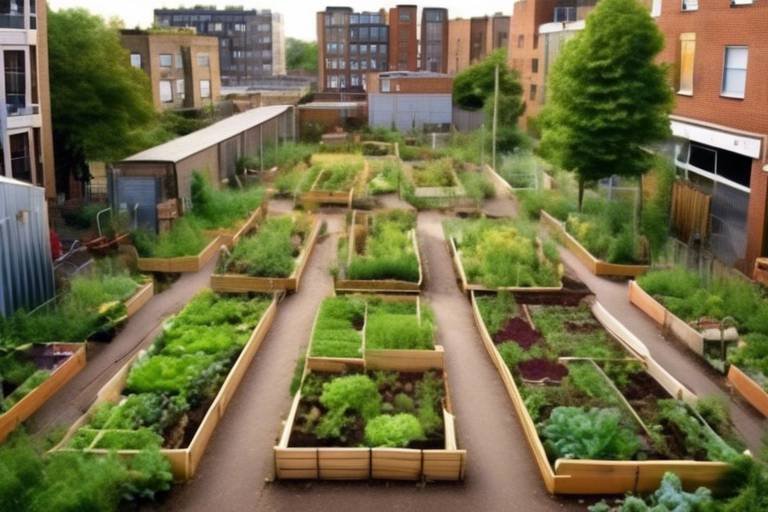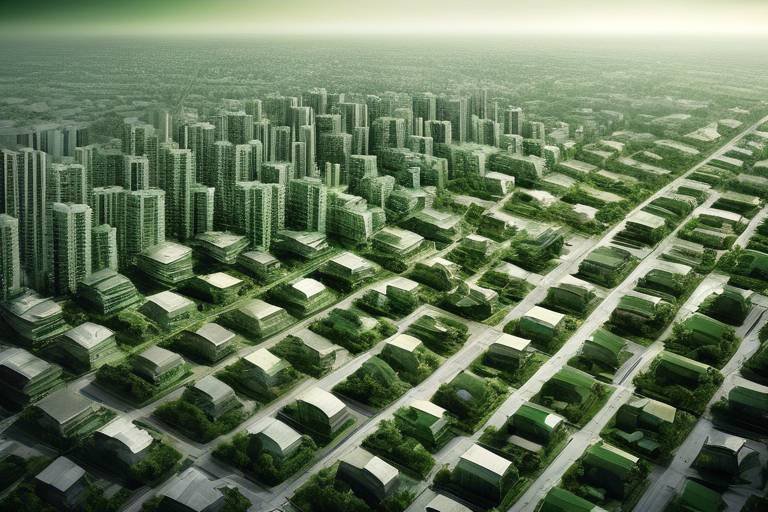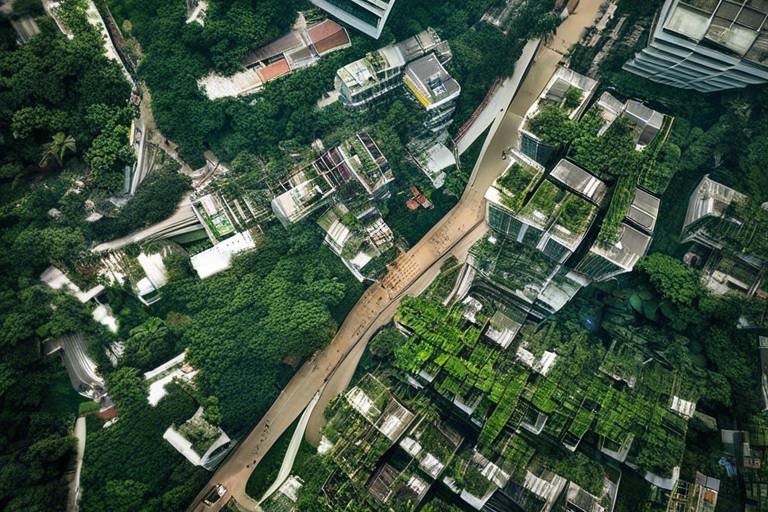The Role of Community Gardens in Urban Sustainability
Community gardens are not just patches of green in our bustling cities; they are vibrant ecosystems that play a pivotal role in enhancing urban sustainability. Imagine stepping into a garden filled with colorful flowers, buzzing bees, and fresh vegetables, all cultivated by local residents who share a passion for sustainability. These gardens do more than beautify neighborhoods; they are vital in addressing pressing challenges like food insecurity, environmental degradation, and social isolation. By bringing people together, community gardens foster a sense of belonging and shared purpose, transforming urban landscapes into thriving hubs of biodiversity and community engagement.
As urban areas continue to expand, the need for sustainable practices becomes increasingly critical. Community gardens provide a unique solution by promoting local food production, enhancing biodiversity, and encouraging environmental stewardship. They serve as a sanctuary for various plant and animal species, offering habitats in concrete jungles. Moreover, they empower residents to take charge of their food sources, leading to healthier lifestyles and stronger community ties. The connection between community gardens and urban sustainability is profound, creating a ripple effect that positively impacts social, economic, and environmental aspects of urban living.
In essence, community gardens act as a bridge between people and nature, reminding us of the importance of nurturing our environment. They encourage us to grow our own food, understand the seasons, and appreciate the beauty of nature right outside our doors. As we delve deeper into the benefits of community gardens, we will uncover how they contribute to biodiversity, food security, and community engagement, making them indispensable in the quest for sustainable urban living.
Community gardens offer numerous advantages that extend beyond just providing fresh produce. They improve air quality, increase green space, and enhance community cohesion. Here are some notable benefits:
- Improved Air Quality: Plants absorb carbon dioxide and release oxygen, contributing to cleaner air.
- Increased Green Space: Community gardens add much-needed greenery to urban areas, which can help reduce the urban heat island effect.
- Enhanced Community Cohesion: These gardens serve as gathering places, fostering friendships and collaboration among residents.
Furthermore, community gardens serve as vital resources for urban residents, promoting healthier lifestyles and environmental awareness. They encourage physical activity, as gardening is a hands-on endeavor that gets people moving. Additionally, these gardens often host workshops and educational programs that teach sustainable practices, nutrition, and the importance of biodiversity. This engagement not only benefits individual participants but also strengthens the fabric of the community as a whole.
Community gardens play a significant role in promoting biodiversity within urban settings. They provide habitats for various species and contribute to essential ecosystem services such as pollination, water management, and soil health. By creating diverse environments, community gardens support the intricate web of life that is crucial for ecological balance.
Creating spaces for pollinators, community gardens support local ecosystems. By planting diverse flora, these gardens attract bees, butterflies, and other essential pollinators, which are crucial for food production and biodiversity. Without these little workers, our food systems would struggle to thrive. The presence of pollinators in community gardens not only enhances the production of fruits and vegetables but also contributes to the overall health of the local environment.
Incorporating native plants into community gardens helps maintain local biodiversity. Native species are better adapted to the local climate and soil conditions, supporting wildlife and reducing maintenance needs. This approach not only conserves resources but also creates a more resilient ecosystem that can withstand environmental changes.
Community gardens enhance soil health through composting and organic gardening practices. Healthy soil contributes to better plant growth and reduces the need for chemical fertilizers, promoting sustainable gardening practices. By prioritizing soil health, community gardens ensure that future generations can continue to grow food in a safe and environmentally friendly manner.
Community gardens serve as platforms for education and engagement, teaching residents about sustainable practices, nutrition, and environmental stewardship. They foster a sense of belonging and shared responsibility among participants. Through hands-on experiences, individuals learn the importance of caring for their environment and the impact of their choices on the planet.
Community gardens address food insecurity by providing fresh produce to urban residents. They promote local food systems, ensuring that communities have access to healthy, affordable food options. In a world where many urban areas struggle with food deserts, community gardens emerge as beacons of hope, offering nutritious alternatives right in the heart of the city.
Urban farming initiatives, often linked to community gardens, expand food production in cities. These programs encourage residents to grow their own food, reducing reliance on commercial food systems and enhancing self-sufficiency. By cultivating their own vegetables and herbs, individuals not only save money but also gain a deeper appreciation for the food they consume.
Community gardens can serve as hubs for food distribution, connecting local growers with consumers. By establishing networks, they help ensure that fresh produce reaches those in need, promoting equitable access to healthy food. This interconnectedness strengthens community bonds and reinforces the idea that everyone deserves access to nutritious food, regardless of their socioeconomic status.
Q: How can I start a community garden in my neighborhood?
A: Start by gathering interested neighbors and researching local regulations. Identify a suitable location, create a plan, and seek community support. Many cities have resources available to help you get started!
Q: What types of plants are best for community gardens?
A: Choose a mix of native plants, vegetables, and herbs that thrive in your local climate. Consider the preferences of the community members who will be using the garden.
Q: How do community gardens help with food security?
A: Community gardens provide fresh produce to urban residents, helping to alleviate food insecurity. They promote local food systems, ensuring access to healthy, affordable food options.

[Benefits of Community Gardens]
Community gardens are not just patches of land filled with vegetables and flowers; they are vibrant ecosystems that bring a multitude of benefits to urban areas. Imagine stepping into a bustling garden, the air filled with the scent of fresh herbs and blooming flowers, where local residents gather to share stories, knowledge, and produce. This scene epitomizes the essence of community gardens, which serve as essential resources for urban dwellers. They enhance air quality, increase green space, and cultivate a sense of community cohesion.
One of the most significant advantages of community gardens is their role in promoting healthier lifestyles. By providing access to fresh fruits and vegetables, these gardens encourage people to adopt better eating habits. Think about it: when you can pluck a ripe tomato right from the vine or gather a handful of leafy greens, it becomes much easier to choose a salad over a fast-food burger. Not only do these gardens improve nutrition, but they also foster environmental awareness. Residents learn about sustainable gardening practices, composting, and the importance of biodiversity, all while engaging in hands-on activities that connect them with nature.
Furthermore, community gardens act as social hubs, bringing together individuals from diverse backgrounds. They create opportunities for people to bond over shared interests and goals, breaking down barriers and building lasting relationships. In a world where urban life can often feel isolating, these gardens offer a refreshing escape, a space where neighbors become friends, and collaboration flourishes. The benefits extend beyond individual well-being; they ripple through the community, enhancing social ties and fostering a sense of belonging.
Moreover, community gardens can significantly improve air quality and mitigate urban heat. The plants absorb carbon dioxide and release oxygen, creating a healthier atmosphere. They also help to combat the urban heat island effect by providing shade and cooling the surrounding air. In essence, these gardens are like natural air conditioners, making our cities more livable and enjoyable.
In summary, the benefits of community gardens are vast and varied. They not only provide fresh produce and promote healthier lifestyles but also enhance community bonds and improve environmental conditions. As urban areas continue to grow, the importance of these green spaces becomes even more pronounced. They are not just gardens; they are lifelines for urban sustainability, connecting people to each other and to the earth.
- What is a community garden? A community garden is a shared space where individuals can grow fruits, vegetables, and flowers, often managed collectively by local residents.
- How can I start a community garden? To start a community garden, gather interested individuals, find a suitable plot of land, and plan your garden layout and crops.
- What are the costs associated with community gardens? Costs can vary, but they often include seeds, tools, soil amendments, and water access. Many gardens also seek local sponsorships or grants to help cover expenses.

[Biodiversity and Ecosystem Services]
Community gardens are more than just patches of green in the urban landscape; they are vital ecosystems that significantly enhance biodiversity. In cities where concrete often dominates, these gardens provide a sanctuary for a variety of species, creating a mosaic of life that contributes to the overall health of the environment. By fostering a rich array of plants and animals, community gardens help to maintain ecological balance, making them indispensable in the quest for sustainable urban living.
One of the primary ways community gardens promote biodiversity is by serving as habitats for numerous organisms. These gardens can attract a range of wildlife, from birds and insects to small mammals. For example, consider the importance of pollinators. Without them, many of the fruits and vegetables we enjoy would simply not exist. Community gardens create a welcoming environment for these essential creatures, providing the food sources they need to thrive. In fact, studies show that urban gardens with diverse plant life can significantly boost local pollinator populations.
Creating spaces for pollinators is crucial, and community gardens excel at this. By planting a variety of flowering plants, gardeners can attract bees, butterflies, and other pollinators, which are vital for food production and biodiversity. Imagine a vibrant garden buzzing with life, where every flower is a beacon for pollinators. This not only supports local ecosystems but also enhances the productivity of the garden itself, leading to more abundant harvests.
Incorporating native plants into community gardens is another effective strategy for promoting biodiversity. Native species are naturally adapted to the local climate and soil conditions, making them resilient and low-maintenance. They provide essential habitats for local wildlife, including insects and birds, which in turn support pollination and seed dispersal. By choosing plants that are native to the area, community gardens can create a thriving ecosystem that not only benefits the garden itself but also the surrounding environment.
Healthy soil is the foundation of any successful garden, and community gardens excel at enhancing soil health through practices like composting and organic gardening. These methods not only improve soil fertility but also promote a diverse microbial community that is crucial for nutrient cycling. Healthy soil leads to better plant growth, reduces the need for chemical fertilizers, and supports sustainable gardening practices. In essence, when we nurture our soil, we are also nurturing the entire ecosystem that depends on it.
In conclusion, community gardens are essential players in the urban ecosystem, enhancing biodiversity and providing valuable ecosystem services. They create habitats for wildlife, support pollinators, integrate native plants, and improve soil health. By fostering these gardens, we are not only cultivating food but also nurturing the environment, ensuring a sustainable future for our urban spaces.
- What are community gardens? Community gardens are shared plots of land where individuals or groups come together to grow plants, vegetables, and flowers, promoting community engagement and sustainability.
- How do community gardens support biodiversity? They provide habitats for various species, attract pollinators, and promote the growth of native plants, all of which contribute to a healthier ecosystem.
- Can anyone participate in a community garden? Yes, most community gardens are open to anyone interested in gardening, and they often encourage participation from all community members.
- What are the benefits of native plants in community gardens? Native plants are better adapted to local conditions, require less maintenance, support local wildlife, and help maintain biodiversity.
- How can I start a community garden? To start a community garden, gather interested individuals, find a suitable location, and collaborate with local organizations for resources and support.

[Pollinator Habitats]
Community gardens are not just patches of green in an urban landscape; they are vital pollinator habitats that play a crucial role in sustaining local ecosystems. Imagine walking through a community garden, surrounded by vibrant flowers and buzzing bees. It’s a beautiful sight, isn’t it? These gardens serve as sanctuaries for essential pollinators like bees, butterflies, and even hummingbirds, which are critical for the reproduction of many plants, including those we rely on for food.
By intentionally planting a variety of flowering plants, community gardens can create a diverse habitat that attracts a wide range of pollinators. This diversity is not just visually appealing; it contributes to the overall health of our urban ecosystems. For instance, a garden with a mix of native and non-native flowers can provide food sources throughout the growing season, ensuring that pollinators have access to nectar and pollen when they need it most. Here’s a quick look at some plants that can help support pollinator populations:
| Plant Type | Pollinator Attraction | Blooming Season |
|---|---|---|
| Sunflower | Bees, Butterflies | Summer |
| Lavender | Bees, Hummingbirds | Summer |
| Milkweed | Butterflies (Monarchs) | Summer |
| Echinacea (Coneflower) | Bees, Butterflies | Summer to Fall |
Moreover, community gardens can serve as educational platforms, teaching urban residents about the importance of pollinators. Workshops can be organized to demonstrate how to create pollinator-friendly spaces, including the use of native plants and sustainable gardening practices. This not only fosters a sense of community but also promotes environmental stewardship among participants.
In addition to providing food and habitat for pollinators, community gardens enhance urban biodiversity. They create a mosaic of green spaces that can help mitigate the effects of urbanization, such as habitat loss and fragmentation. By integrating pollinator habitats into urban planning, cities can improve their resilience against environmental challenges, making them more sustainable and livable.
So, the next time you see a community garden, remember that it’s more than just a place to grow vegetables. It’s a thriving ecosystem that supports pollinators, enhances biodiversity, and contributes to a healthier urban environment. Let’s celebrate and support these green spaces, as they are essential to our food systems and the health of our planet.
- What are pollinators, and why are they important? Pollinators, such as bees and butterflies, are organisms that help plants reproduce by transferring pollen. They are essential for the production of many fruits and vegetables.
- How can I create a pollinator-friendly garden? Plant a variety of native flowering plants, avoid pesticides, and provide water sources to attract and support pollinators.
- Can community gardens help with food security? Yes, community gardens can provide fresh produce, improve access to healthy food, and promote local food systems.

[Native Plant Integration]
Integrating native plants into community gardens is not just a trend; it’s a vital strategy for enhancing local biodiversity and sustainability. Native plants are those that naturally occur in a specific region, and they have adapted to the local climate, soil, and wildlife over thousands of years. By incorporating these plants into community gardens, we can create a thriving ecosystem that supports a variety of organisms, from insects to birds. Imagine a garden that not only looks beautiful but also buzzes with life, where every flower and shrub plays a role in the local food web.
One of the primary benefits of using native plants is their low maintenance requirements. Since these plants are adapted to the local environment, they typically require less water, fewer fertilizers, and minimal pest control compared to non-native species. This not only saves time and resources for gardeners but also promotes a more sustainable gardening practice. In a world where water scarcity is becoming a pressing issue, every drop counts, and native plants help conserve this precious resource.
Additionally, native plants provide essential habitats for local wildlife. They offer food and shelter for various species, including pollinators like bees and butterflies, which are crucial for the reproduction of many plants, including those we rely on for food. By planting a diverse array of native flora, community gardens can become sanctuaries for these important creatures. For example, a garden that features milkweed can attract monarch butterflies, while sunflowers can draw in honeybees. This interconnectedness between plants and animals is key to maintaining a healthy ecosystem.
Moreover, native plants can enhance the aesthetic value of community gardens, creating vibrant spaces that reflect the local landscape. When we think of a garden, we often envision colorful blooms and lush greenery. By choosing native species, gardeners can create a mosaic of colors and textures that change with the seasons, providing year-round beauty. It’s like painting a picture with nature’s palette, where every brushstroke contributes to the overall masterpiece.
To effectively integrate native plants into community gardens, it’s crucial to consider which species will thrive in the specific conditions of the garden. Factors such as soil type, sunlight exposure, and moisture levels all play a significant role in determining the success of these plants. Local extension services or native plant societies can provide valuable resources and guidance on selecting the right plants for a community garden. Furthermore, educational workshops can be organized to teach community members about the importance of native plants and how to care for them.
In conclusion, the integration of native plants into community gardens is a powerful way to promote biodiversity, reduce maintenance needs, and create beautiful, sustainable spaces. By embracing these local flora, we not only enhance our gardens but also contribute to the health of our environment. As we cultivate these gardens together, we foster a deeper connection to our natural surroundings, nurturing both the land and our community.
- What are native plants? Native plants are species that naturally grow in a specific region without human intervention.
- Why should I use native plants in my garden? They require less maintenance, conserve water, and provide habitat for local wildlife.
- How do I know which native plants to choose? Consider factors like soil type, sunlight, and moisture levels, and consult local resources for guidance.
- Can native plants attract pollinators? Yes! Native plants are essential for attracting and supporting pollinators like bees and butterflies.

[Soil Health Improvement]
One of the most remarkable aspects of community gardens is their ability to significantly improve soil health. Healthy soil is the foundation of a thriving garden and is essential for producing nutritious food. In community gardens, various practices are employed to enhance soil quality, which ultimately leads to better plant growth and yields.
For instance, many community gardeners engage in composting, a natural process that transforms organic waste into nutrient-rich soil amendments. By recycling kitchen scraps, yard waste, and other organic materials, gardeners create compost that enriches the soil with essential nutrients. This not only improves soil fertility but also enhances its structure, allowing for better water retention and aeration.
Additionally, community gardens often utilize organic gardening practices, which eschew harmful chemical fertilizers and pesticides. Instead, gardeners might opt for natural alternatives, such as using green manure (cover crops that are tilled back into the soil) or mulching to suppress weeds and retain moisture. These methods contribute to a healthier ecosystem, promoting beneficial microorganisms that play a crucial role in soil health.
It's fascinating to see how community gardens create a ripple effect in the surrounding environment. As the soil improves, it supports not only the plants but also the entire food web of the garden, including insects, worms, and other organisms. The result is a vibrant ecosystem that thrives on biodiversity.
To illustrate the impact of these practices, consider the following table, which outlines the benefits of improved soil health in community gardens:
| Soil Improvement Practice | Benefits |
|---|---|
| Composting | Enhances nutrient content, improves soil structure, and reduces waste. |
| Organic Gardening | Promotes biodiversity, reduces chemical runoff, and improves plant resilience. |
| Mulching | Suppresses weeds, retains moisture, and adds organic matter to the soil. |
| Crop Rotation | Prevents soil depletion, reduces pest and disease buildup, and improves soil structure. |
Ultimately, the commitment to improving soil health in community gardens not only benefits the gardeners but also contributes to a more sustainable urban environment. As these gardens flourish, they serve as a model for how urban spaces can transform into green havens that promote environmental stewardship and sustainable living. So, the next time you bite into a fresh tomato or savor a homegrown cucumber, remember that the health of the soil plays a pivotal role in your meal’s journey from garden to table.
- What is the importance of soil health in community gardens?
Soil health is crucial for plant growth and nutrient availability. Healthy soil supports a diverse ecosystem, which enhances the overall productivity of the garden. - How can I improve soil health in my garden?
Practices like composting, mulching, and using organic gardening methods can significantly improve soil health. - What are the benefits of composting?
Composting enriches soil with nutrients, improves soil structure, and reduces waste by recycling organic materials. - Can community gardens help with food security?
Yes, community gardens provide fresh produce to urban residents, promoting local food systems and enhancing access to healthy food options.

[Community Engagement and Education]
Community gardens are not just plots of land where vegetables grow; they are vibrant hubs of engagement and education. Imagine walking into a garden filled with the sounds of laughter, the scent of fresh herbs, and the sight of neighbors working side by side. These gardens create a sense of belonging that transcends mere gardening. They bring people together, fostering connections that can last a lifetime. Through hands-on experiences, community members learn about sustainable practices, nutrition, and the importance of environmental stewardship.
One of the most exciting aspects of community gardens is their ability to educate participants of all ages. Workshops and events are often organized to teach vital skills such as composting, organic gardening, and cooking with fresh produce. For instance, children can learn where their food comes from, while adults can discover the benefits of eating locally grown fruits and vegetables. This exchange of knowledge creates a ripple effect, empowering individuals to make informed choices about their health and the environment.
Moreover, community gardens often collaborate with local schools and organizations to provide educational programs. These initiatives can include:
- Hands-on Workshops: Teaching practical skills like planting, harvesting, and cooking.
- School Programs: Involving students in garden activities to enhance their understanding of agriculture and ecology.
- Volunteer Opportunities: Encouraging community members to contribute their time and skills, fostering a sense of shared responsibility.
In addition to practical education, community gardens serve as platforms for exploring important social issues such as food justice and environmental sustainability. Through discussions and events, participants can engage in conversations about access to healthy food, the impact of urbanization on local ecosystems, and the role of community in addressing these challenges. This engagement not only enriches the community but also empowers individuals to advocate for positive change.
Ultimately, the educational aspect of community gardens is about more than just growing food; it’s about cultivating a community culture that values sustainability, health, and collaboration. As people come together to learn and share, they build relationships that strengthen their neighborhoods and improve their quality of life. In this way, community gardens become a vital part of the urban landscape, offering not just food, but also a sense of purpose and connection.
Here are some common questions about community gardens:
- What is a community garden? A community garden is a shared space where individuals come together to grow plants, vegetables, and flowers, promoting community involvement and sustainable practices.
- How can I get involved in a community garden? You can usually find local community gardens through neighborhood associations, social media, or community centers. They often welcome new members and volunteers.
- What are the benefits of participating in a community garden? Participating in a community garden can improve your physical health, enhance social connections, and provide educational opportunities related to gardening and sustainability.
- Can community gardens help with food security? Yes, community gardens provide fresh produce to local residents, helping to alleviate food insecurity in urban areas.

[Food Security and Accessibility]
Community gardens are not just patches of green in urban landscapes; they are lifelines for many residents facing food insecurity. In cities where access to fresh produce can be a challenge, these gardens provide a vital source of nutritious food. Imagine walking through your neighborhood and seeing vibrant tomatoes, leafy greens, and colorful peppers growing just a few blocks away. This is not just a dream; it's a reality for many who participate in community gardening initiatives.
By cultivating local food systems, community gardens ensure that fresh, affordable produce is within reach for everyone. They play a crucial role in addressing the disparities in food access that many urban areas face. For instance, low-income neighborhoods often lack grocery stores that stock healthy options. Community gardens bridge this gap, allowing residents to grow their own food right in their backyards or community plots.
Moreover, these gardens foster a sense of community and collaboration. When residents come together to plant, tend, and harvest, they are not just growing food; they are building relationships and creating a support network. This communal spirit can lead to shared resources, such as tools and knowledge, enhancing the overall gardening experience. For example, a seasoned gardener might share tips on pest control or composting with a newbie, creating a cycle of learning and growth.
In addition to providing fresh produce, community gardens can also serve as hubs for food distribution. They can connect local growers with consumers, ensuring that the fruits of their labor reach those in need. This is particularly important in urban areas where food deserts exist. By establishing networks that link growers directly to consumers, community gardens promote equitable access to healthy food. Imagine a local farmer's market where the produce is grown just a few blocks away, ensuring freshness and reducing transportation costs.
Furthermore, community gardens often engage in educational initiatives that teach residents about nutrition and sustainable practices. Workshops on cooking with fresh produce or understanding the benefits of a plant-based diet can transform how individuals view food. This education empowers residents to make healthier choices, ultimately improving their overall well-being.
In summary, community gardens are pivotal in enhancing food security and accessibility in urban settings. They not only provide fresh produce but also foster community ties and promote sustainable practices. By participating in these gardens, residents can take charge of their food sources, ensuring that they have access to healthy, affordable options. The impact of community gardens goes beyond just food; they create a sense of belonging and shared responsibility that enriches urban life.
- What is a community garden?
A community garden is a shared space where individuals come together to grow fruits, vegetables, and flowers, promoting community engagement and sustainability. - How can I start a community garden?
Starting a community garden involves gathering interested participants, securing land, and planning the layout and types of plants to grow. - What are the benefits of community gardens?
Community gardens provide fresh produce, enhance community ties, promote biodiversity, and educate residents about sustainable practices. - How do community gardens help with food insecurity?
They provide access to fresh, affordable food for urban residents, especially in areas where grocery stores are scarce.

[Urban Farming Initiatives]
Urban farming initiatives are transforming the way we think about food production in cities. These programs are not just about growing food; they represent a shift in how communities engage with their environment, their neighbors, and their own health. Imagine stepping out of your apartment and into a vibrant garden where fresh vegetables and herbs are flourishing, all cultivated by local residents. This is the essence of urban farming—a movement that empowers individuals and communities to take charge of their food sources.
One of the key benefits of urban farming initiatives is their ability to enhance self-sufficiency. By encouraging residents to grow their own food, these programs reduce reliance on commercial food systems, which can often be costly and less accessible. Urban farms often provide workshops and training sessions, teaching participants essential skills such as planting, harvesting, and preserving food. This hands-on experience not only equips individuals with knowledge but also fosters a sense of pride and ownership over their food.
Moreover, urban farming initiatives often work in tandem with community gardens to create a network of local food systems. This interconnectedness allows for the sharing of resources, knowledge, and produce among community members. For instance, a neighborhood might have several small urban farms that collectively grow a variety of crops. By pooling their resources, they can establish a local farmers' market, where residents can buy fresh produce directly from the growers. This not only supports local economies but also ensures that food is fresher and more nutritious.
Urban farms also play a crucial role in addressing food deserts—areas where access to fresh, healthy food is limited. By establishing farms in these neighborhoods, communities can directly combat food insecurity. A study conducted in several urban areas revealed that neighborhoods with active urban farming initiatives saw a significant decrease in food insecurity rates. This is primarily because residents have greater access to fresh produce, which is essential for maintaining a healthy diet.
In addition to improving food access, urban farming initiatives contribute to environmental sustainability. They utilize permaculture practices and organic gardening techniques that minimize waste and promote biodiversity. For example, many urban farms incorporate composting systems that recycle organic waste into nutrient-rich soil. This not only enhances soil health but also reduces the amount of waste sent to landfills. Furthermore, by growing food locally, urban farms help decrease the carbon footprint associated with transporting food over long distances.
In summary, urban farming initiatives are more than just a trend; they are a vital part of the movement towards sustainable urban living. They empower individuals, strengthen community ties, and promote healthier lifestyles while addressing pressing issues like food security and environmental challenges. As cities continue to grow, the importance of these initiatives will only increase, paving the way for a future where urban spaces are not just concrete jungles, but thriving ecosystems of food production and community engagement.
- What are urban farming initiatives? Urban farming initiatives are programs that promote the cultivation of food within urban environments, encouraging residents to grow their own food and enhance local food systems.
- How do urban farms help with food security? Urban farms provide direct access to fresh produce in areas that may lack grocery stores, thereby addressing food insecurity and promoting healthier eating habits.
- Can anyone participate in urban farming? Yes! Urban farming initiatives are often community-driven and welcome participation from residents of all ages and backgrounds.
- What skills can I learn from urban farming? Participants can learn a variety of skills, including planting, harvesting, composting, and sustainable gardening practices.
- Are urban farms environmentally friendly? Yes, many urban farms utilize sustainable practices that promote biodiversity, reduce waste, and minimize carbon footprints.

[Food Distribution Networks]
Community gardens are not just about growing food; they also play a pivotal role in establishing food distribution networks that connect local growers with consumers. These networks are essential in creating a sustainable urban food system, particularly in areas where access to fresh produce is limited. Imagine a vibrant community garden bustling with activity—neighbors exchanging tips on gardening, children learning about plants, and families gathering to harvest fresh vegetables. This scenario is not just a dream; it’s a reality made possible through effective food distribution networks.
At the heart of these networks are the community gardens themselves, which often serve as hubs of activity. They provide a space for local farmers and gardeners to collaborate, share resources, and distribute their produce. This collaboration not only increases the availability of fresh fruits and vegetables but also fosters a sense of community ownership and pride. By establishing connections between local growers and consumers, community gardens help ensure that fresh produce reaches those who need it most, especially in underserved urban areas.
Moreover, community gardens can facilitate the creation of food cooperatives or partnerships with local businesses, enhancing their distribution capabilities. For instance, a local grocery store might partner with a nearby community garden to source fresh produce directly, thereby reducing transportation costs and ensuring that the produce is as fresh as possible. This direct connection between growers and consumers can lead to more equitable access to food, as it often results in lower prices for fresh produce.
Additionally, community gardens can utilize modern technology to streamline their distribution processes. For example, many gardens are now implementing online platforms where consumers can place orders for fresh produce directly from the growers. This not only makes it easier for consumers to access healthy food options but also allows gardeners to manage their inventory more effectively. Through these platforms, they can communicate directly with the community, providing updates on what’s available and when it will be ready for harvest.
Furthermore, community gardens can play a crucial role in addressing food insecurity by collaborating with local food banks and organizations. By donating surplus produce, these gardens can help feed those in need while simultaneously raising awareness about the importance of local food systems. This symbiotic relationship not only benefits the community but also strengthens the garden’s role as a vital resource for urban residents.
In conclusion, the food distribution networks established by community gardens are essential for promoting food security and accessibility in urban areas. By connecting local growers with consumers, these networks not only enhance the availability of fresh produce but also foster a sense of community and shared responsibility. As we continue to face challenges related to food access and sustainability, community gardens stand out as a beacon of hope, demonstrating the power of collaboration and local action.
- What are food distribution networks? Food distribution networks are systems that connect local growers with consumers, ensuring that fresh produce is accessible to everyone, especially in urban areas.
- How do community gardens contribute to food security? Community gardens provide fresh produce directly to local residents, reducing reliance on commercial food systems and ensuring equitable access to healthy food options.
- Can community gardens partner with local businesses? Yes, many community gardens partner with local businesses to enhance their distribution capabilities and provide fresh produce to the community.
- How can technology improve food distribution from community gardens? Technology can streamline distribution processes through online platforms, allowing consumers to order fresh produce directly from growers.
Frequently Asked Questions
- What are community gardens?
Community gardens are shared spaces where individuals come together to grow fruits, vegetables, and flowers. They not only provide fresh produce but also foster a sense of community among participants.
- How do community gardens promote urban sustainability?
Community gardens enhance urban sustainability by improving air quality, increasing green spaces, and promoting biodiversity. They also help reduce the urban heat island effect and support local wildlife.
- What role do community gardens play in food security?
Community gardens directly address food security by providing access to fresh, healthy produce for urban residents. They encourage local food systems, making nutritious food more accessible and affordable.
- Can anyone participate in a community garden?
Yes! Community gardens are typically open to anyone interested in gardening. Participation may vary by garden, so it's best to check with local organizers for specific guidelines.
- How do community gardens enhance biodiversity?
Community gardens contribute to biodiversity by creating habitats for various species, including pollinators. They often incorporate native plants, which support local wildlife and promote ecosystem health.
- What educational opportunities do community gardens offer?
Community gardens serve as educational platforms, teaching participants about sustainable gardening practices, nutrition, and environmental stewardship. Workshops and events often provide hands-on learning experiences.
- How can I start a community garden in my area?
To start a community garden, gather interested individuals, find a suitable location, and seek permission from landowners or local authorities. It's also helpful to connect with local gardening organizations for support and resources.
- What are some challenges faced by community gardens?
Challenges may include securing land, obtaining funding, managing resources, and maintaining community engagement. Addressing these challenges often requires strong organization and collaboration among participants.
- How do community gardens impact mental health?
Engaging in gardening activities can significantly improve mental health by reducing stress, promoting physical activity, and fostering social connections. The act of nurturing plants can be therapeutic and rewarding.



















